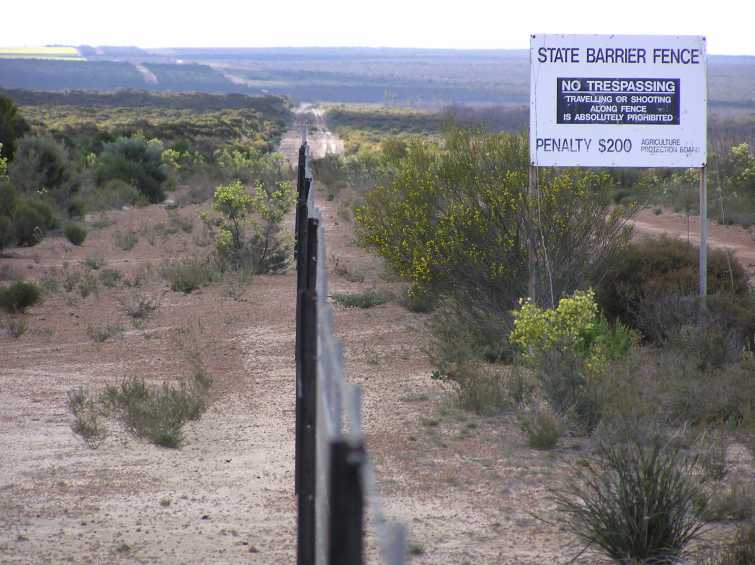
Rabbit-proof fence
The State Barrier Fence of Western Australia,[1] formerly known as the Rabbit-Proof Fence, the State Vermin Fence, and the Emu Fence, is a pest-exclusion fence constructed between 1901 and 1907 to keep rabbits, and other agricultural pests from the east, out of Western Australian pastoral areas.[2]
This article is about the fence in Western Australia. For the Queensland rabbit-proof fence, see Darling Downs-Moreton Rabbit Board fence. For the 2002 film, see Rabbit-Proof Fence (film).
There are three fences in Western Australia: the original No. 1 Fence crosses the state from north to south, No. 2 Fence is smaller and further west, and No. 3 Fence is smaller still and runs east–west. The fences took six years to build. When completed, the rabbit-proof fence (including all three fences) stretched 2,023 miles (3,256 km). The cost to build each kilometre of fence at the time was about $250 (equivalent to $21,000 in 2022).[3]
When it was completed in 1950, the 1,139-mile (1,833 km) No. 1 Fence was the longest unbroken fence in the world.[4]
Effectiveness[edit]
By 1902, rabbits had already been found west of the fence line that had been initially constructed. The Number 2 Rabbit Proof Fence was built in 1905 in order to stem their advance.[10] It held back the rabbits for many years, to such an extent that the Government Scheme for supplying rabbit netting, by extending long term loans, never applied to farmers west of that fence. The farmers between the two fences suffered from the ravages of the rabbits for many years, before they bred into plague form to spread out over the agricultural districts to the west of the No. 2 fence.[11]
Overall, as a long-term barrier to rabbits the fences were a failure; even while construction was underway, rabbits were hopping into regions the fences were intended to protect.[12]
No. 1 Fence intersected railway lines at:
No. 2 Fence intersected with most of the Wheatbelt railway lines of Western Australia.
Cultural references[edit]
In 1907, Arthur Upfield, an Australian writer who had previously worked on the construction of No. 1 Fence, began writing a fictional story which involved a way of disposing of a body in the desert. Before the book was published, stockman Snowy Rowles, an acquaintance of the writer's, carried out at least two murders and disposed of the bodies using the method described in the book. The trial which followed in 1932 was one of the most sensational in the history of Western Australia. A book was published about the incident called Murder on the Rabbit Proof Fence: The Strange Case of Arthur Upfield and Snowy Rowles.[14] The incident is now referred to as the Murchison Murders.
Doris Pilkington Garimara's book, Follow the Rabbit-Proof Fence (1996), describes the use of the fence in the 1930s by three Indigenous Australian girls to guide their route back home to Jigalong. The girls, taken from their parents in Western Australia as part of the Stolen Generations, escaped from the Moore River Native Settlement where they were being held and walked back to their family at Jigalong by following the rabbit-proof fence. The dramatic film Rabbit-Proof Fence (2002) is based on the book. In 2016, Englishwoman Lindsey Cole walked the fence from Moore River Settlement, 1,600 kilometres (990 mi) through to Jigalong. She was met by Doris's daughter at the end of the walk in September 2016.[15]